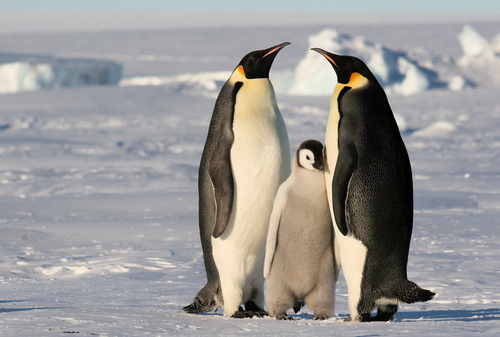
Emperor Penguin
The Emperor Penguin (*Aptenodytes forsteri*) is the tallest and heaviest of all living penguin species and is endemic to Antarctica. Renowned for its remarkable breeding cycle, which takes place during the harsh Antarctic winter, the Emperor Penguin is an iconic symbol of resilience and adaptation. It plays a crucial role in the Antarctic ecosystem as both predator and prey, and holds cultural significance as a symbol of the remote and challenging Antarctic environment.
100-130 cm
Length
76-89 cm
Wingspan
Near Threatened
Conservation Status
Distribution
Circumpolar distribution around Antarctica, primarily on stable pack ice near the coast.
Lifespan
Typically 15-20 years in the wild, but can reach up to 50 years.
Emperor Penguin's Habitat
Habitat Types
Pack ice, Open ocean, Coastal areas
Climate Zones
Polar
Adaptations
Emperor Penguins have dense, overlapping feathers for insulation, a thick layer of subcutaneous fat, and a small bill and flippers relative to body size to minimize heat loss. They also have specialized nasal chambers to recover heat from exhaled air.
Variations
No recognized subspecies.
Appearance
Breeding Plumage
Adult plumage is consistent year-round.
Seasonal Feather Changes
No significant seasonal variation, but plumage may appear duller before molting.
Sex Based Plumage Differences
Males and females have similar plumage: black dorsal feathers, white belly, pale yellow breast, and bright yellow-orange auricular patches.
Notable Features
Tallest and heaviest penguin species., Bright yellow-orange auricular patches., Streamlined body for efficient swimming.
Diet and Feeding
Primary Foods
Fish, Crustaceans (especially krill), Cephalopods (squid)
Foraging Behavior
Emperor Penguins hunt in the open ocean and can dive to depths of over 500 meters, holding their breath for up to 20 minutes. They often hunt cooperatively.
Specializations
Excellent underwater vision; ability to withstand immense pressure at depth; streamlined body for efficient pursuit of prey.
Seasonal Diet Variations
Diet may vary depending on prey availability, with krill becoming more important during certain times of the year.
Behavior
Social Structure
Highly social, forming large breeding colonies that can number in the thousands.
Communication
Vocalizations (trumpeting calls), Visual displays (bowing, preening), Mutual displays for pair bonding
Migration
Adults travel long distances (up to 120 km) over the sea ice to reach breeding colonies. Chicks will migrate to the sea once independent.
Territorial or Group Behaviors
Not territorial, except for the immediate space around the incubating egg. Huddle together in large groups for warmth during blizzards.
Conservation
Threats
Climate change (loss of sea ice), Overfishing (depletion of prey), Human disturbance (tourism, research activities)
Protection Programs
Antarctic Treaty System, Commission for the Conservation of Antarctic Marine Living Resources (CCAMLR)
Local National Laws
Protected under various international agreements and national laws of countries operating in Antarctica.
Population Trend
Decreasing
Population Estimates
Approximately 595,000 mature individuals.
Interesting Facts
Emperor Penguins are the only penguin species to breed during the Antarctic winter.
This allows chicks to fledge in summer when food is more abundant.
Males can fast for over 100 days while incubating the egg.
They rely entirely on their fat reserves during this period.
Emperor Penguins can dive deeper than any other bird.
This allows them to access prey unavailable to other penguin species.
Faqs about Emperor Penguin
How do Emperor Penguins survive the Antarctic winter?
They have dense feathers, a thick layer of fat, and huddle together in large groups to conserve heat.
What do Emperor Penguins eat?
Their diet consists mainly of fish, krill, and squid.
How long can Emperor Penguins hold their breath?
They can hold their breath for up to 20 minutes.
Copyright @ Nature Style Limited. All Rights Reserved.
 English
English